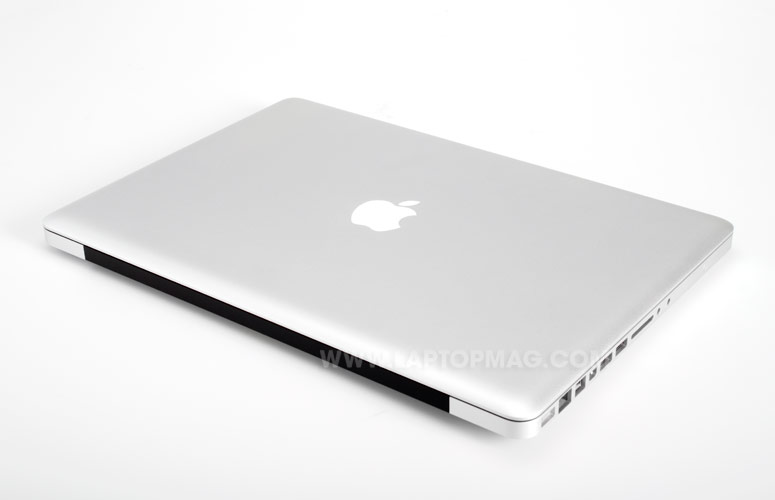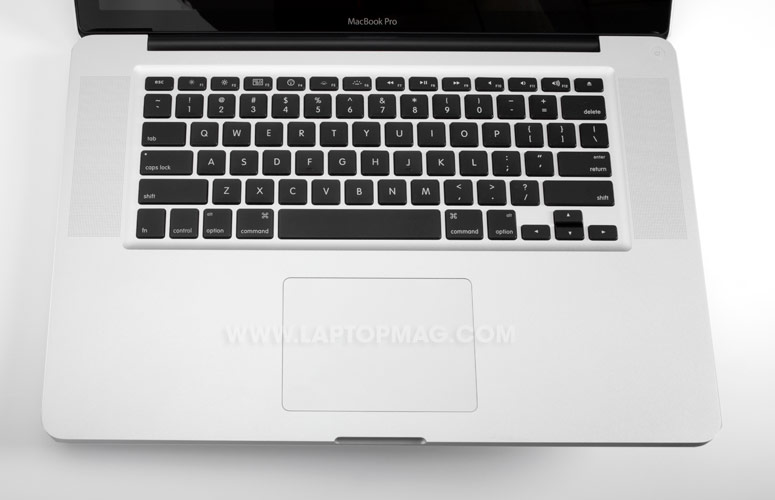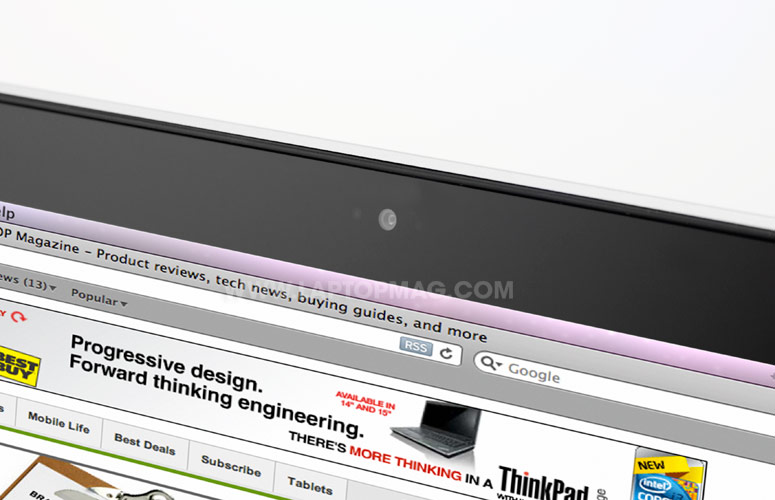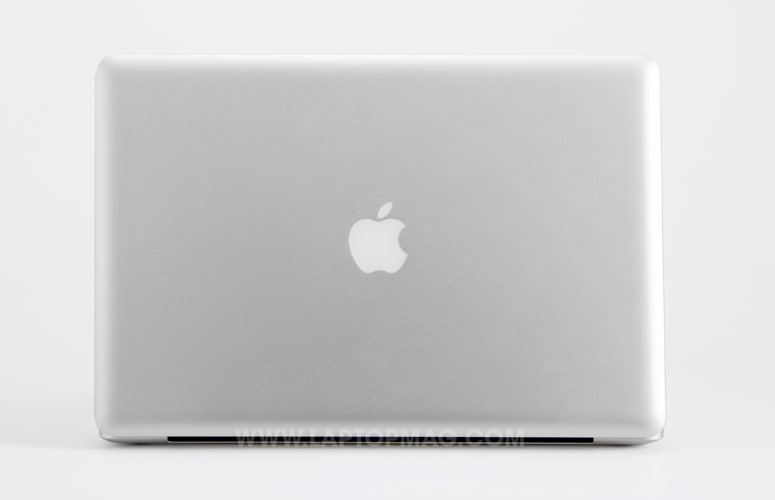Laptop Mag Verdict
Packed with cutting-edge technologies, the latest MacBook Pro is the most powerful and longest lasting 15-inch notebook money can buy.
Pros
- +
Excellent performance
- +
Next-gen Thunderbolt technology
- +
Powerful, automatic switchable graphics
- +
High-quality FaceTime HD camera
- +
Great keyboard and touchpad
Cons
- -
Bottom runs warm
- -
Pricey
Why you can trust Laptop Mag
Last year when Apple updated its 15-inch MacBook Pro, it packed a Core i7 CPU and switchable graphics into the company's iconic unibody aluminum chassis. Apple is upping the ante again, this time with Intel's second-gen Core processor, AMD graphics, a high-definition webcam, and Thunderbolt, a new high-speed connection that can transfer an entire HD movie in less than 30 seconds. Plus, this powerhouse still delivers excellent battery life. Apple kept the price the same as before (starting at $1,799; $2,199 as configured), so how much more do you get for your money?
Design
The 15-inch MacBook Pro sports the same carved-from-a-single-chunk-of-metal unibody design as before, with a sturdy aluminum chassis and rounded edges. The overall look is classy and modern, though it makes upgrading individual components (such as the RAM and hard drive) difficult, as the entire bottom must be unscrewed.
The 15-inch MacBook Pro has the same dimensions (14.4 x 9.8 x 1 inches) and weight (5.6 pounds) as the previous version. While we definitely felt the extra heft while carrying the machine home, it did fit in our messenger bag, which is more than we can say about most 15-inch notebooks. The Dell XPS 15, for example, weighs a pound more and measures a bulkier 15 x 10.4 x 1.3 to 1.5 inches. Regardless, the MacBook Pro will take up an entire airline tray table.
Click to enlarge
Heat
The 15-inch MacBook Pro held up well during our heat test, where we play a Hulu video at full screen for 15 minutes. The space between the G and H keys registered 90 degrees Fahrenheit, and the touchpad measured just 83 degrees. However, the back rear bottom of the notebook reached an uncomfortable 106 degrees.
Sign up to receive The Snapshot, a free special dispatch from Laptop Mag, in your inbox.
Keyboard and Touchpad
Similar to other MacBook Pros, our unit featured a shallow keyboard with black, isolated keys that provided solid feedback when typing URLs and writing documents. The keys are backlit, a feature that can be activated manually or by the ambient light sensor, which will illuminate the keys when typing in low-light situations (such as a darkened plane cabin). While we were typing in a dark room, the soft glow enabled us to see the keys clearly.
Click to enlarge
Apple was the first company to introduce mouse buttons integrated into the touchpad itself, and while others have imitated this feature, the MacBook Pro's touchpad remains the best. Not only is it huge--4.1 x 3 inches--but we could easily execute multitouch gestures like pinch to zoom, rotate, and swiping four fingers down to see all open windows (Expose).
Display and Audio
As before, we loved the bright and crisp 15.4-inch display on the MacBook Pro. Its resolution of 1440 x 900 pixels is adequate, though we suspect many photographers and other creative pros will opt for the 1680 x 1050-pixel option ($100). When we watched videos streamed from Hulu, reflections from the glossy display weren't overwhelming, though it's nice to know there's an anti-glare option--though only for the higher-resolution display ($150). Still, colors were bright, blacks were deep and dark, and viewing angles were excellent both vertically and horizontally.
Click to enlarge
Speakers on either side of the keyboard provided very good audio. At full volume, Beyonce Knowles' vocals filled a small room. Higher tones were crisp without sounding distorted; lower notes, such as the bass line in the song, had enough presence, though we would prefer a little more punch.
Thunderbolt and Ports
The newest addition to the MacBook Pro's ports is Thunderbolt, formerly known as Light Peak. This connection, which shares the same port as the Mini DisplayPort, has theoretical throughput of 10 Gbps. This port also carries up to 10 watts of electricity, so you can use Thunderbolt peripherals, such as external hard drives, without having to plug in an extra source of power. Thunderbolt will also let you daisy-chain up to six devices, so you can have several hard drives connected to an external monitor, which should please movie editors who like to use larger displays. While there are no peripherals that yet support this interface (the earliest will be this summer), Apple provided a demonstration where it was able to duplicate a 4.42GB folder in 10 seconds. That's a rate of 452.6 MBps.
Click to enlarge
Otherwise, the ports remain the same: On the right side of the 15-inch MacBook Pro you'll find the 8X SuperDrive and Kensington lock slot. Built into the left side are two closely placed USB 2.0 ports, Mini DisplayPort (shared with Thunderbolt), a FireWire 800 port, the MagSafe power port, and headphone and mic jacks. The memory card slot has been updated to accept XDHC cards, which means higher speeds and capacity.
FaceTime and HD Camera
Apple has updated the webcam in the 15-inch MacBook Pro to support a 720p video. Also, the FaceTime app, first seen on the iPhone, now comes pre-loaded on the MacBook Pro. It defaults to portrait mode--a carryover from its phone days--but you can switch it to a landscape view. While it's capable of sending 720p video, the system will only send a high-definition stream if the recipient's notebook can handle it. In a FaceTime call to another MacBook user, we both saw bright, vivid colors (the yellow on our caller's shirt really popped), and images were crisp and smooth.
Click to enlarge
Click to enlarge
Performance
Like Windows-based notebooks, Apple is updating its laptops with Intel's second-generation Core processors. Our 15-inch MacBook Pro came with a 2.2-GHz Intel Core i7-2720QM processor and 4GB of RAM. After installing Windows 7, we ran PCMark Vantage in Boot Camp and saw a score of 7,648; that's tops in the 15-inch notebook category, whose average is 4,764, and about 1,000 points higher than the previous MacBook Pro (6,699). The only systems that scored higher--and cost less--had SSDs: the Lenovo ThinkPad T410s (11,264) and the Sony VAIO Z (9,475). The15-inch MacBook Pro's Geekbench score of 10,874 was double the previous generation (5,422).
Booting into Mac OS X 10.6 took the 750GB hard drive a speedy 44 seconds, the same as the previous generation. In OS X, we duplicated a 4.97GB folder of multimedia in 2 minutes and 20 seconds, a rate of 36.4 MBps. That's about 12 MBps faster than the category average.
The benefits of the built-in media encoder on Intel's second-gen Core processor were also evident when we transcoded a 114MB MPEG-4 to AVI using Oxelon Media Encoder. It took the new 15-inch MacBook Pro just 37 seconds, 10 seconds faster than the previous model, and 45 seconds faster than the average. We then used CyberLink MediaEspresso to convert a 5-minute 1080p video to an iPod touch format. The program, using the AMD GPU to accelerate conversion, took 1 minute and 24 seconds to complete the task. That's 46 seconds faster than the category average.
Graphics
For the latest generation of MacBook Pros, Apple has switched from Nvidia to AMD GPUs. On our 15-inch model, the Nvidia GeForce GT330M chip was replaced with an AMD Radeon HD 6750M and 1GB of DDR5 memory. However, like the previous generation, the 15-inch MacBook Pro features switchable graphics--this time with an integrated Intel HD Graphics 3000 GPU.
As with the last generation of MacBook Pros, users no longer have to log out or suffer through a few seconds' delay while the notebook switches chips; the changeover is now seamless and instantaneous. Unlike Nvidia's Optimus technology, which routes everything through the integrated GPU (but produces the same result), Apple's method shuts off the GPU that's not in use. In this manner, Apple claims better battery life while still delivering more horsepower when needed. When software senses that an application is using graphics frameworks such as Core Graphics, OpenGL, or Quartz Composer, it will turn on the discrete GPU. Users can also disable automatic switchable graphics in the Energy Saver control panel, but doing so will cause the discrete GPU to stay on at all times.
On 3DMark06 (running in Boot Camp), the discrete AMD GPU scored 10,359, which is more than double the category average (3,559) and about 3,250 points more than the previous 15-inch MacBook Pro. It beats out dedicated gaming rigs such as the ASUS G53Jw, whose Nvidia GTX 460 GPU notched 8,640, but it's in a virtual tie with the HP Envy 17; that machine's ATI Mobility Radeon HD 5850 GPU powered the system to a score of 10,482.
Not surprisingly, the MacBook Pro's gaming performance is nothing to sneeze at. With graphics set to maximum and the screen resolution at native, the machine notched 43 frames per second in World of Warcraft; that's well above the category average of 27 fps, but below systems such as the Asus U41Jf-A1 (62 fps); to be fair, that notebook has a discrete GeForce GT 425M GPU with 1GB of DDR3 RAM, but a lower-res 1366 x 768 display. The older MacBook Pro notched 69 fps at the same settings, but WOW has become much more graphically demanding in the intervening year.
Battery Life
We never expect stellar battery life out of 15-inch notebooks, yet that's where the 15-inch MacBook Pro really stands out. On our LAPTOP Battery Test (continuous web surfing over Wi-Fi), the notebook lasted 5 hours and 25 minutes; that's an hour and a half longer than the mainstream average, and almost equal to the ultraportable average, but it's below the expected 7-hour runtime Apple quotes; we will retest this system and update the review.
Ed. Note (3/2/11): After re-running our battery test twice, the MacBook Pro saw its endurance increase to 8 hours and 23 minutes.
Configurations
While we tested the most expensive pre-configured version, Apple offers three different configurations of the 15-inch MacBook Pro. The base model--if you consider $1,799 a base price--comes with a 2.0GHz Quad-core Intel Core i7 processor, 4GB of RAM, a 500GB hard drive, and Intel HD Graphics 3000 and AMD Radeon HD 6490M with 256MB of video memory.
All the models are customizable; users can select up to a 512GB SSD which itself, at $1,200, costs as much as a 13-inch MacBook Pro. A 1680 x 1050 display is $100 extra, and one with an anti-glare coating costs $50 on top of that.
Software and Warranty
One of the best value adds that Apple offers is the software package on its systems. The15-inch MacBook Pro includes Apple's iLife ‘09 creativity suite (GarageBand, iMovie, iPhoto, and iWeb), Front Row, Photo Booth, and its Time Machine backup software. This year's additions, brought over from the iPad and iPhone, are the App Store, which makes it even easier to discover and download new software, and Facetime. While we're glad the MacBook Pro doesn't have any trialware on it, we would like to see a word processor that's a little less rudimentary than TextEdit.
Click to enlarge
Apple's standard warranty remains: one-year limited parts-and-labor and 90 days of toll-free, 24/7 phone support. The AppleCare Protection Plan, which includes three years each of parts-and-labor coverage and phone support, costs $249. To see how Apple fared on our Tech Support Showdown, click here.
Verdict
You've got to credit Apple for finding a winning formula and tweaking it in just the right places. The new 15-inch MacBook Pro not only outperforms its predecessor, but also just about every other notebook by a fair margin. It has the same svelte design, yet incorporates next-generation Intel and AMD processors as well as Thunderbolt for high-speed data transfers. As always, though, Apple products command a premium: $2,199 is a steep price to pay for such performance. By comparison, a Dell XPS 15 with the same processor, but 6GB of RAM, a 7,200-rpm 750GB hard drive, Nvidia GeForce GT540M graphics (and 2GB of video memory), a 1920 x 1080 screen, Blu-ray, a Skype-certified 2-MP webcam, and a nine-cell battery, costs about $700 less. Still, that system is much bulkier, weighs a pound more, and, even with the larger battery, doesn't last as long on a charge. As always, if you want the best, you have to pay for the best.
Click to enlarge
Apple MacBook Pro (15-inch 2011) Specs
| Bluetooth | Bluetooth 2.1+EDR |
| Brand | Apple |
| CPU | 2.2-GHz Intel Core i7-2720QM |
| Card Slots | 2-1 card reader |
| Company Website | http://www.apple.com |
| Display Size | 15.4 |
| Graphics Card | AMD Radeon HD 6750M/Intel HD Graphics 3000 |
| Hard Drive Size | 750GB |
| Hard Drive Speed | 5,400rpm |
| Hard Drive Type | SATA Hard Drive |
| Native Resolution | 1440x900 |
| Operating System | OS X 10.6 (Snow Leopard) |
| Optical Drive | DVD SuperMultiDrive |
| Optical Drive Speed | 8X |
| Ports (excluding USB) | Kensington Lock, Headphone, Firewire 800, Ethernet, Thunderbolt/mini DisplayPort, Microphone |
| RAM | 4GB |
| RAM Upgradable to | 8GB |
| Size | 14.4 x 9.8 x 1 inches |
| Touchpad Size | 4.1 x 3.0 |
| USB Ports | 2 |
| Video Memory | 1GB |
| Warranty/Support | One-year limited parts-and-labor and 90 days of toll-free, 24/7 phone support |
| Weight | 5.6 pounds |
| Wi-Fi | 802.11b/g/n |
| Wi-Fi Model | Broadcom 802.11n |
Michael was the Reviews Editor at Laptop Mag. During his tenure at Laptop Mag, Michael reviewed some of the best laptops at the time, including notebooks from brands like Acer, Apple, Dell, Lenovo, and Asus. He wrote in-depth, hands-on guides about laptops that defined the world of tech, but he also stepped outside of the laptop world to talk about phones and wearables. He is now the U.S. Editor-in-Chief at our sister site Tom's Guide, where he oversees all evergreen content and the Homes, Smart Home, and Fitness/Wearables categories for the site..






